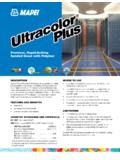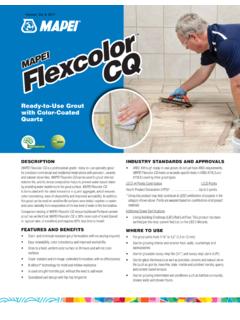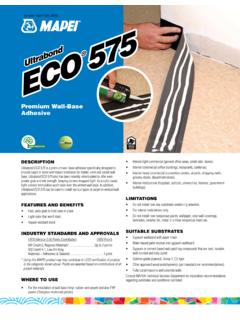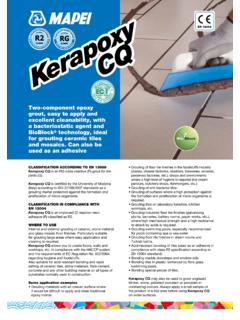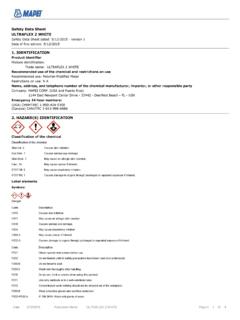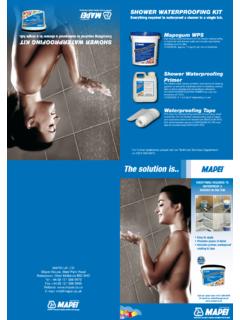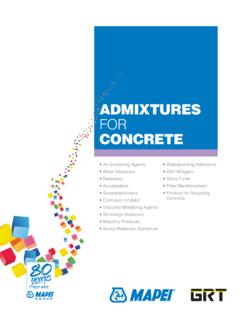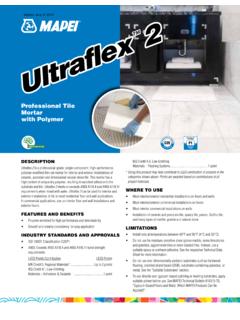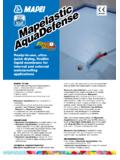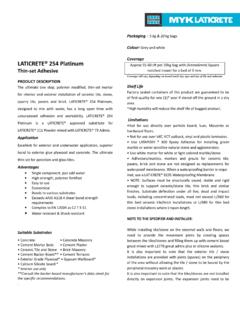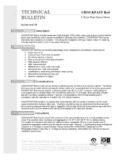Transcription of Premium Sanded Grout with Polymer - Mapei
1 DESCRIPTIONK eracolor S Sanded Grout is a Premium -grade, pre-blended, Polymer -modified Sanded Portland-cement tile Grout that requires only the addition of water for mixing. It will Grout joints from 1/8" to 5/8" (3 to 16 mm).FEATURES AND BENEFITS For interior/exterior floors and walls Contains BioBlock technology for mold and mildew resistanceINDUSTRY STANDARDS AND APPROVALS ISO 13007: Classification CG2WA ANSI: Meets or exceeds ANSI industry standardsLEED v3 Points Contribution LEED PointsMR Credit 5, Regional Materials* ..Up to 2 pointsIEQ Credit , Low-Emitting Materials Adhesives & Sealants ..1 pointIEQ Credit , Low-Emitting Materials Flooring Systems ..1 point* Using this product may help contribute to LEED certification of projects in the categories shown above.
2 Points are awarded based on contributions of all project TO USE For grouting interior/exterior residential and commercial floor and wall surfaces in dry or wet conditions For grouting dimensional stone, slate, granite, stone agglomerates and most types of ceramic, ceramic mosaic, quarry, brick paver, porcelain, glass and clay tiles For joint widths from 1/8" to 5/8" (3 to 16 mm) For application in submerged conditions (swimming pools, spas, water features and fountains), once fully cured (after 21 days)LIMITATIONS Do not install over substrates containing asbestos. Do not use to Grout joints less than 1/8" (3 mm) wide. Instead, use Keracolor U Unsanded Grout , Ultracolor Plus FA or an appropriate Mapei epoxy Grout (see the respective Technical Data Sheet [TDS] for details).
3 Do not use when a highly chemical-, impact- and stain-resistant Grout is required or in heavy industrial tile installations. Instead, use an appropriate Mapei epoxy Grout (see the respective TDS for details). When grouting in temperatures above 80 F (26 C), see the Technical Bulletins at or consult Mapei s Technical Services Mapei s Technical Services Department for recommendations regarding installation over substrates and conditions not PREPARATION Certain tiles with high absorption, surface porosity or rough surfaces may require sealing before grouting to prevent permanent Sanded Grout with PolymerSanded GroutSanded GroutKeracolor SKeracolor SVersion: Sept. 15, 2017 The application of a Grout release over certain types of porcelain or textured surface tiles or stone may be advantageous where a fine surface porosity might trap fine cement particles or color pigments.
4 Seek the advice of the tile or stone manufacturer and site-test (mock up) on separate samples before grouting. Caution: Some types of glazed ceramic tiles, marble, granite and marble agglomerates can be permanently stained, scratched, dulled or damaged when grouted with pigmented Grout or Sanded Grout formulas. Generally, white Grout is best suited for grouting white or light-colored marble or granite. Take all the necessary precautions to ensure that the marble, granite or tiles are compatible with colored grouts. Check the tile or marble manufacturer s literature and test Grout on a separate sample area before grouting to determine the suitability of the product with colored and/or Sanded grouts. Before grouting, make sure the tiles or stones are firmly set and the adhesive or mortar is completely dry.
5 Remove all spacers, pegs, ropes and strings. Grout joints must be clean and free of standing water, dust, dirt and foreign matter. Remove excess adhesive or mortar from the joint area so that 2/3 of the depth of the tile is left available for grouting. Clean the tile or stone surface thoroughly to remove dust, dirt and other contaminants that may cause Grout Mapei s Surface Preparation Requirements document in the Reference & Installation Guides section of the Tile & Stone Installations Systems page on Mapei s Website. MIXINGC hoose all appropriate safety equipment before use. Refer to the Safety Data Sheet for For best results, have the same person mix all of the Grout . Consistent mixing techniques will promote more uniform Before mixing the Grout with water, dry-blend the product so that the finished Grout does not show color variations, which may arise due to pigment settling during shipment.
6 If two or more bags are to be used, dry-blend all of the contents Mix Keracolor S Sanded Grout with cool, clean water or an approved Mapei additive. Mix by using the following water-to- Grout proportions:Water Keracolor S Sanded Grout oz. (74 mL)..1 lb. (0,45 kg)13 oz. (384 mL) ..5 lbs. (2,27 kg)26 oz. (769 mL) ..10 lbs. (4,54 kg)2 qts. (1,89 L) ..25 lbs. (11,3 kg)1 gal. (3,79 L) ..50 lbs. (22,7 kg)4. Pour the required amount of clean, cool water into a clean mixing container. Gradually add the proportionate amount of Keracolor S Sanded Grout while slowly mixing. To avoid shade variation in the finished Grout joints, always add the powder to the water while being consistent in the mixing process and with the quantity of water used from batch to Mix thoroughly with a low-speed mixer (at about 350 rpm) for about 3 to 5 minutes, or until obtaining a smooth, creamy, homogenous paste consistency and a uniform shading of the colored Avoid prolonged mixing, which could trap air and shorten the pot Allow the Grout to sit ( slake )
7 In the container for about 5 Remix for about 1 to 2 minutes without adding more liquid or Wash hands and mixing tools with water immediately after APPLICATIONRead all installation instructions thoroughly before Use only at temperatures between 50 F and 100 F (10 C and 38 C). 2. Using consistent application and cleaning procedures will produce consistent To aid in spreading the Grout , slightly moisten the tile or stone surface with a damp sponge just before application. Do not flood the tiles or allow water to stand in the ungrouted joint Force Keracolor S Sanded Grout into the joints with a rubber Grout float. Make sure all joints are well-compacted and free of voids and Remove excess Grout from the tile surface, moving the Grout float diagonally to the joints while the Keracolor S Sanded Grout is still The Grout surface should be flush with the tile Some stiffening may occur before all material is used (usually within about 1 hour at room temperature).
8 If this occurs, simply remix but do not add any Provide for expansion and control joints as specified per TCNA Handbook method EJ171 or TTMAC Specification Guide 09300, Detail Allow the Keracolor S Sanded Grout to firm up in the joints sufficiently to avoid damaging the Grout surface, usually in 15 to 30 minutes depending upon the temperature, humidity and absorption rate of the tile or Use two buckets of cleaning water: one for rinsing the majority of the Grout residue from the Grout sponge, and one for moistening the sponge in clean Dip the sponge in a bucket of water and wring out the excess, so that the sponge does not drip water. Using Sanded Gr ou tSanded Gr ou tKeracolor SKeracolor Svery little pressure, pull the sponge diagonally across the Grout joints to remove the excess Grout from the tile surface.
9 Also use the sponge to smooth the surface of the Grout joint. Turn the sponge over and make another pass in an adjacent area. After using both sides, rinse the sponge in one bucket and wring out the excess water. Dip the sponge in the second bucket of water, wringing out the excess and continuing the Change the water in the buckets frequently to help limit the amount of haze that forms on the tile or stone To prevent efflorescence, discoloration and soft/powdery joints, avoid cleaning with excessive To control color variations and minimize efflorescence, buff the grouted surface with cheesecloth or a clean, dry cotton cloth when a haze is visible on the tile surface, usually one to two hours after grouting. This should remove any remaining surface water or Grout Clean hands and tools with clean, soapy water while the Grout is Never use acid for cleaning marble, glazed tile or pigmented Grout surfaces.
10 If a persistent haze remains after normal cleaning, see the Technical Bulletins at or consult Mapei s Technical Services Provide for dry, heated storage on site and deliver materials at least 24 hours before tilework begins. For residential showers and tub surrounds, restrict use for 24 to 48 hours after grouting. For steam showers, restrict use for 14 days after grouting. For at least 21 days after grouting, protect the installation from freezing and water immersion (see the TDS of the adhesive or setting system for details). Floors: Keep the Grout installation free from heavy traffic for at least 72 hours after grouting. Walls: Protect the Grout installation from impact, vibration and hammering on adjacent and opposite walls for 14 days after tile installation (see the TDS of the adhesive or setting system for details).
